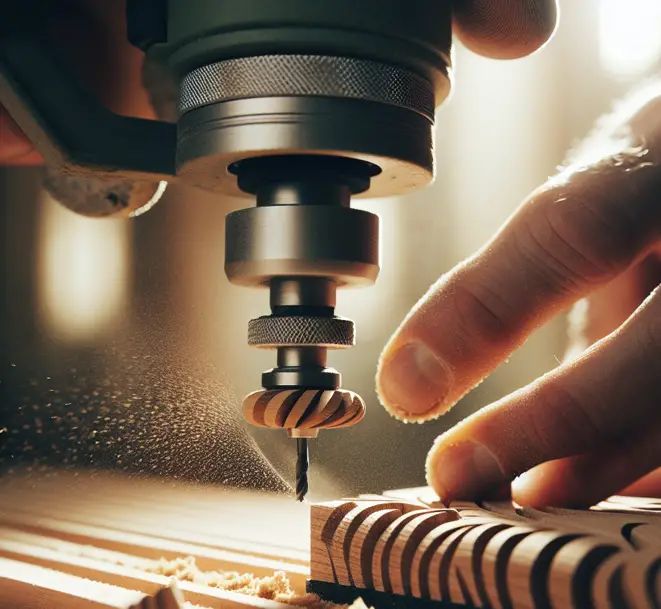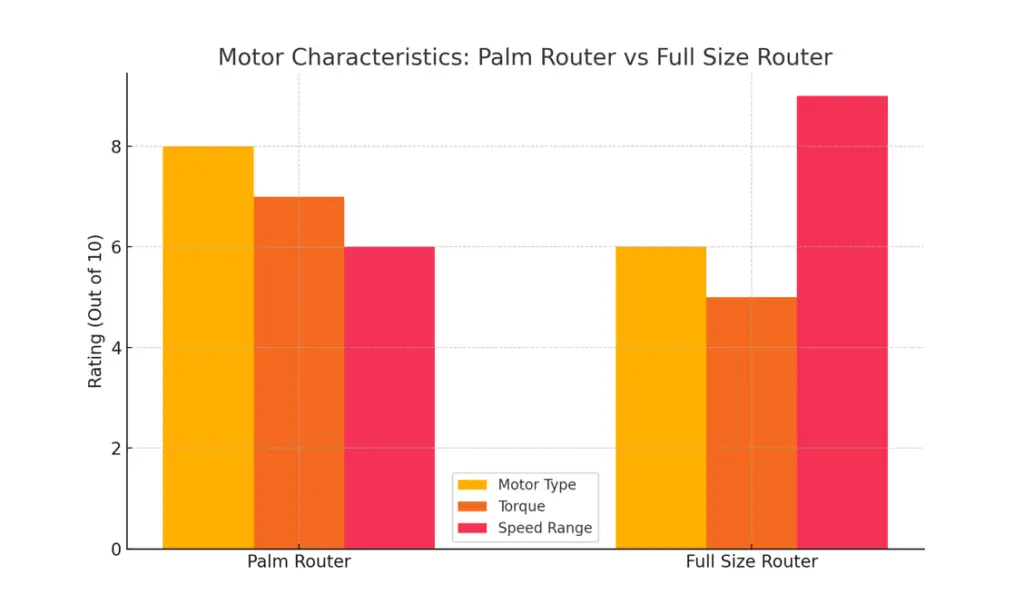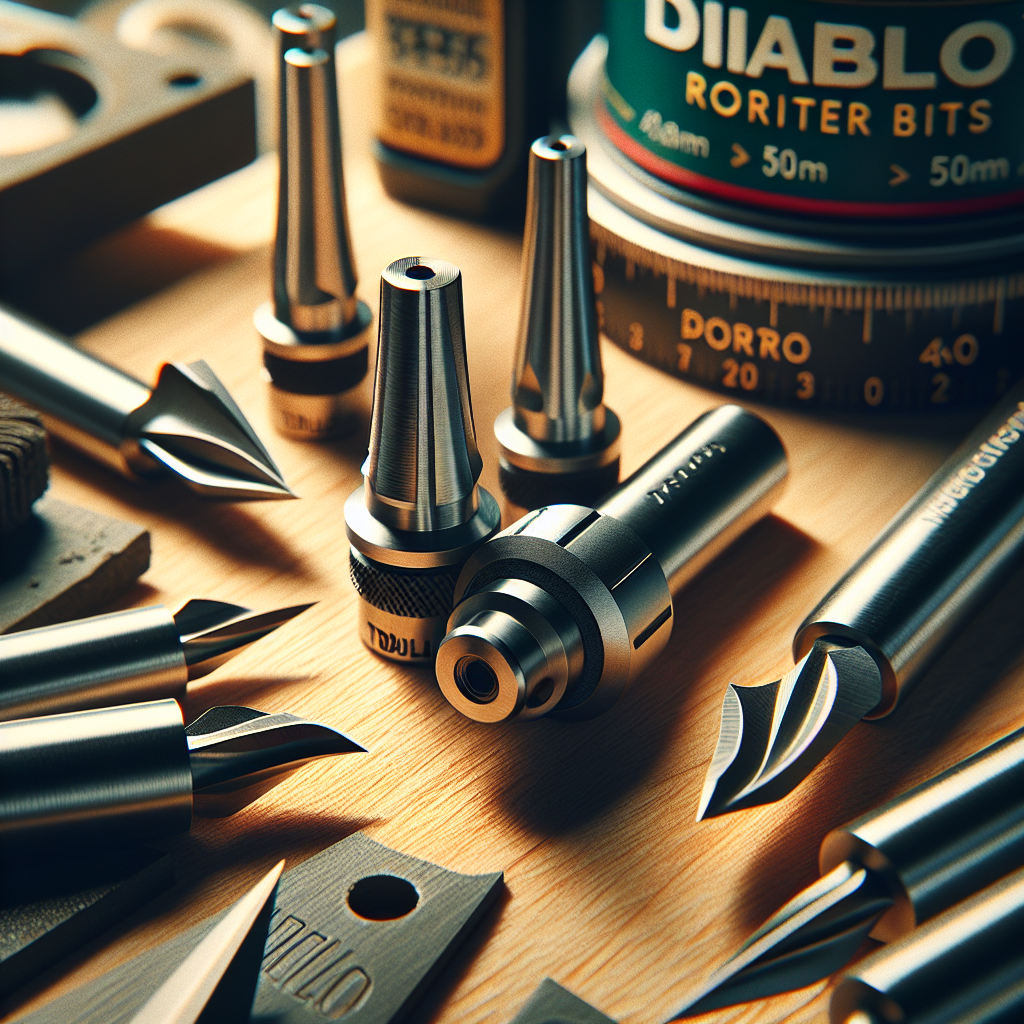Palm Router or Full Size? [11 Differences You Should Know!]
When it comes to routers, one of the key considerations is size – do you want a full-sized router that likely offers more features and connectivity options, or a smaller, more portable palm router? Both have their advantages and disadvantages that are worth exploring.
Here’s an in-depth look at palm routers versus full size routers to help you decide which is best for your workshop.

Palm Router Overview
A palm router, also known as a trim router, is a small, lightweight router that’s designed to be held and controlled with one hand. The router’s motor housing is compact enough that you can grip it like a palm sander.
Palm routers typically have motors in the 1 to 2 horsepower range. They use smaller cutting bits, usually 1/4-inch or 1/2-inch shank bits. The bases are relatively small – 5 to 6 inches in diameter. And they can handle depths of cut up to around 1 to 1-1/2 inches.
Some key features of palm routers:
- Lightweight – Usually 3 to 5 pounds
- Compact – Fits in one hand
- Less powerful – Lower horsepower motors
- Smaller – Uses smaller bits
- Shallow cutting depth – Usually 1 inch max
- Excellent control – Easy to handle
Discover everything you need to know about palm routers in this detailed guide.
Full Size Router Overview
A full size router is bigger and more powerful than a palm router. The motor is housed in a larger body that requires two-handed operation.
Full size routers have motors in the 1-1/2 to 3-1/2 horsepower range. They use larger cutting bits, usually 1/2-inch or 1/4-inch shanks. The bases can range from 6 inches up to 13 inches in diameter. And they can handle cutting depths over 2 inches.
Some key features of full size routers:
- Heavier – Around 7 to 15 pounds
- Larger – Requires two hands
- More powerful – Higher horsepower motors
- Bigger bits – Uses larger diameter bits
- Deeper cuts – 2 inches or more
- Versatile – More accessories available
- Plunge capability – Makes plunge cuts
So in summary, full size routers are more powerful, versatile tools for doing bigger, deeper cuts. Palm routers are lighter and more maneuverable for detail work.
1. Comparing Power and Size
The main differences between palm and full size routers come down to power and size.
Power
Palm routers have less powerful motors, typically 1 to 2 horsepower. This gives you enough power to rout edges or small profiles. But they lack the torque for big cuts.
Full size routers start around 1-1/2 HP and go up to 3-1/2 HP for the most powerful models. This gives you plenty of power for deep cuts and using large diameter bits in hardwoods.
Size
Palm routers are compact and very lightweight at around 3 to 5 pounds. You control them with one hand, like a palm sander.
Full size routers are heavier, weighing 7 to 15 pounds. Their larger motor housings and bases require two handed control. Their bases also tend to be bigger – 1-1/4″ to 3-1/4″ vs. 6″ to 13″ for full size routers.
2. Cutting Depth
Another key difference is cut depth capacity.
Palm routers have very limited cutting depth. Most top out at around 1″. Some of the more powerful models may go to 1-1/2″.
This allows you to rout profiles and edges. But you can’t make deep grooves or mortises.
Full size routers can handle cutting depths over 2″. The most powerful models can go to 3″ or more. This gives you the depth capacity for mortises, grooves, rebates, and other deep cuts.
So for deeper cuts, a full size router is necessary. For shallow profiles and edges, palm routers work well.
3. Precision and Control
Palm routers really shine when it comes to fine precision work. Their one-handed control gives you a few advantages:
- Excellent maneuverability – The compact size and lightweight design allows you to make precise movements. You can pivot and turn the router easily.
- Comfortable to use – The palm router feels like an extension of your hand. You can work comfortably for longer periods.
- Less tiring – The light weight of a palm router means less fatigue during extended use.
- Safety – Your second hand is free to securely hold the workpiece for added safety.
So for things like fine trimming, edge work, hinge mortising, and other precision tasks, a palm router gives you superior control.
Full size routers are more difficult to finesse due to their size and two-handed operation. You can add accessories like edge guides for better precision. But in general, palm routers are better for fine detailed work.
4. Versatility
Full size routers are more versatile tools overall. Here are some of the advantages full size routers have:
- Plunge cutting – Full size routers allow plunge cuts with depth stops. You can plunge into the middle of a workpiece. Difficult with a palm router.
- Bigger bits – Full size routers use large diameter bits up to 3-1/2″. Palms max out around 1/2″ to 1″.
- More accessories – More bases, tables, lifts, and other accessories are made for full size routers. Palms have minimal accessories.
- Thickness planing – Full size routers can be mounted under a table for thickness planing. Not practical with a palm router.
- Sign making – Full size routers excel at sign making with large bits. Palms lack the power and depth.
- Grooving – Deep grooving in thick stock requires a full size router. Palms are limited to shallow grooving.
So while palm routers have great precision and control, full size routers can handle a wider range of cuts and tasks. Their accessories also make them more flexible.
5. Cost Considerations
Palm routers are generally less expensive than full size routers. Here are some typical prices:
- Palm routers – $100 to $200
- Full size routers – $120 to $600
The most expensive full size routers are 3+ HP professional models. But even an entry-level fixed-base router will run over $120.
So palm routers are the budget friendly option. You can get excellent capability for modest cost.
This makes them ideal for woodworkers who only occasionally need to use a router. You can get palm router functionality without a big investment.
For those who use routers heavily, a full size router is worth the added cost for its versatility. But part-time users may not need that capability.
6. Learning Curve
Palm routers are generally easier tools for routing beginners to learn on. Here are some of the advantages:
- Lightweight – The lightweight design gives you better control of the tool. It’s less likely to pull out of your hands.
- Compact size – One handed operation is simpler to learn. You don’t have to coordinate two hands.
- No plunge cutting – Fixed-base operation only simplifies the learning process.
- Lower power – Less powerful motors are more forgiving until you get the hang of routing.
- Shallow cuts – Learning with shallow cuts is safer and less stressful.
With their precision and gentle learning curve, palm routers allow you to safely learn routing fundamentals. Full size routers involve a steeper learning curve.
Once you know the basics, it’s easier to graduate to a full size router. Their greater capabilities do require more skill to use well. But palm routers let you get there in easy steps.
7. Motor Type
Another distinguishing factor is the motor design:
Palm routers typically use universal or series wound motors. They offer high torque in a compact package. Variable speed allows lower RPMs for control. Lightweight field windings let you power the router with one hand.
Full size routers tend to use induction motors. An induction design optimizes high horsepower in a small motor. It generates less torque at low speeds. But most full size router work occurs in the 8,000 to 24,000 RPM optimal range.
So each motor type is well suited for its respective tool. But in general, universal motors offer better speed control and low end torque. Induction motors optimise raw power in a compact housing.

8. Base Platform Options
The base platform is another major difference between palm and full size routers.
Palm routers use a fixed base platform. There is no plunge capability. The motor is locked at a set height in the base. This simplified design contributes to the tool’s precision, control and low cost.
Full size routers offer both fixed and plunge base options:
- Fixed base – Similar control to a palm router fixed base. Offers basic routing capabilities.
- Plunge base – Allows plunging the bit into the middle of a workpiece. Far more versatile for advanced cuts.
- Combo kits – Let you switch between fixed and plunge bases on a single motor housing. Gives you the best of both worlds.
So full size routers give you plunge cutting capability for advanced work. But the basic fixed base functions similarly to a palm router.
9. Bit Shank Size
The small size of palm routers dictates that they use smaller bit shanks – usually 1/4″ or 1/2″. This limits the variety of speciality profile bits available to them.
Full size routers predominantly use 1/2″ shank router bits. This is the most common size with the widest selection of bit types and profiles.
It’s also the most rigid shank size for large diameter bits. Small shanks can flex and lead to chatter.
This gives full size routers more options for bigger diameter and specialised profiling bits. Palm routers are somewhat limited in bit selection by the smaller shanks required.
10. Dust Collection
Palm routers don’t have great dust collection built in. Some models come with dust ports, but most eject fine dust into the air.
Full size routers often have dust collector ports and work well with vacuums. Plunge bases, in particular, can be used with dust collection to contain most of the debris.
Poor dust collection is an annoyance of palm routers. Be prepared to wear a mask and clean up the resulting dust cloud.
11. Router Table Mounting
Palm routers can be mounted in a router table. Their compact size requires building a custom table platform to raise the bit.
But in practice, palm routers are awkward in router tables. The short bit shanks lack rigidity. And the low power is problematic for table routing.
Full size routers are well suited for table mounting. Their longer bits provide better rigidity. And the higher motor power handles hardwoods and large profiling bits easily.
For table routing, a full size router is definitely the way to go. Palm routers are best used freehand rather than table mounted.
Common Uses for Palm Routers
Here are some of the most common uses for palm routers in the workshop:
- Edge profiling – Round over edges, chamfer, shape profiles
- Decorative edging – Detail work like roundovers on table aprons
- Trim laminates – Rout the edges of laminate countertops
- Light mortising – Shallow hinge and lock mortises
- Template following – Precision following of guides and templates
- Light grooving – Slots and grooves up to 1″ deep
- Sign lettering – Engraving lettering in signs
- Precision inlay – Detail routing for inlay banding
- Dovetail cleaning – Finessing dovetail joints
- Mini carving – Detail carving and engraving
Palm routers really excel at fine detail precision work on edges and profiles. Their lightweight handling is perfect for these types of tasks.
Common Uses for Full Size Routers
Full size routers handle all of the heavier routing tasks:
- Mortising – Deep router-made mortises
- Grooving – Stopped grooves, dadoes, rabbets
- Edge shaping – Heavy roundovers and edge profiling
- Joint making – Dovetails, boxes, finger joints
- Sign making – Dimensional routing with large bits
- Raised panels – Shaping and profiling
- Thickness planing – Planing stock under a router table
- Decorative edging – Deep, artistic edges
- Cutting recesses – Recesses for tile, inlays
If you need deep cuts, heavy profiling, or specialised joint making, a full size router is the best tool for the job. Their power and versatility is unmatched.
Recommendations
So when should you choose a palm router vs. a full size router? Here are some recommendations:
Get a palm router if you:
- Are new to routing and want an easy learning experience
- Only occasionally need to use a router
- Work primarily on small stock under 1″ thick
- Want great precision control with edging and light profiling
- Need to do detail work like hinge mortises and trim laminates
- Are on a tight budget
Get a full size router if you:
- Are an experienced woodworker doing advanced work
- Rout frequently and need maximum versatility
- Work on stock 1-1/2″ or thicker
- Need deep grooves, mortises, or profiling
- Want accessories like a router table, lifts, stops, etc.
- Make complex joints like dovetails
- Do signs, dimensional work, or decorative edges
For most hobbyists, starting with an affordable palm router makes sense. Down the road you can add a plunge router for advanced capabilities. Their precision and ease of use makes palm routers a perfect entry level tool.
Professionals or serious hobbyists will appreciate the versatility of a full size router. But they aren’t mandatory if you mainly do lighter stock edging and profiling work.
Let your needs and experience level guide your purchasing decision. And consider getting both for maximum routing flexibility.
Conclusion
Palm routers and full size routers each have distinct strengths making them ideal for different applications. Choosing between them means weighing power vs. precision, depth capacity vs control, and versatility vs. affordability.
For light precision work, shallow edging, and easy learning, palm routers lead the way. Their one-handed control provides masterful finesse on small profiling tasks.
When you need raw power, deep cuts, versatility, and advanced features, full size routers are unmatched. From fine joinery to dimensional sign making, they can handle almost any routing task.
Ideally, woodworkers eventually end up with both types of routers. Palm routers provide a compact precision tool for detail work. Full size routers offer power and flexibility for mortises, grooves, joints, and heavy cuts.
Choose the router suited to your current needs and skills. And over time, add the other style to expand your routing horizons. With both palm and full size routers, you’ll be fully equipped to route edges, make joints, and embellish your projects beautifully.
Discover everything you need to know about palm routers in this detailed guide.

